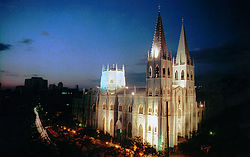PHILIPINES ,SAN SEBASTIAN CHURCH
MADE OF STEEL IN ASIA INAGURATED
ON 1891 AUGUST 16
The Basílica Menor de San Sebastián, better known as San Sebastian Church, is a Roman Catholic minor basilica in Manila, Philippines and the seat of the Parish of San Sebastian.
Completed in 1891, San Sebastian Church is noted for its architectural features. an example of the revival of Gothic architecture in the Philippines, it is the only all-steel temple in the Philippines,[1]
[2] and is the only prefabricated steel church in the world.
[3] In 2006, San Sebastian Church was included in the Tentative List for possible designation as a World Heritage Site. It was designated as a National Historical Landmark by the Philippine government in 1973.
[4]San Sebastian Church is under the care of The Order of the Augustinian Recollects, who also operate a college adjacent to the basilica. It is located at Plaza del Carmen, at the eastern end of Recto Avenue, in Quiapo, Manila.
[5]In 1621, Bernardino Castillo, a generous patron and a devotee of the 3rd-century Roman martyr Saint Sebastian, donated the land upon which the church stands.
The original structure, made of wood, burned in 1651 during a Chinese uprising. Succeeding structures, which were built of brick, were destroyed by fire and earthquakes in 1859, 1863, and 1880.[5]
In the 1880s, Esteban Martínez, the parish priest of the ruined church, approached the Spanish architect Genaro Palacios, with a plan to build a fire and earthquake-resistant structure made entirely of steel.
Palacios completed a design that fused Earthquake Baroque with the Neo-Gothic style.[5] His final design was said to have been inspired by the famed Gothic Burgos Cathedral in Burgos, Spain.[5]
| San Sebastian Basilica | |
|---|---|
| Basílica Menor de San Sebastián | |
 | |
| 14°35′59″N 120°59′21″E | |
| Location | Quiapo, Manila |
| Country | |
| Denomination | Roman Catholic |
| History | |
| Dedication | St. Sebastian |
| Architecture | |
| Status | Minor basilica |
| Functional status | Active |
| Heritage designation | National Cultural Treasure |
| Designated | August 15, 2011 |
| Architect(s) | Genaro Palacios |
| Groundbreaking | 1888 |
| Completed | 1891 |
| Specifications | |
| Materials | steel, mixed sand, gravel & cement |
| Administration | |
| Archdiocese | Roman Catholic Archdiocese of Manila |
| Province | Ecclesiastical Province of Manila |
| Clergy | |
| Archbishop | H.E. Luis Antonio G. Cardinal Tagle, D.D., S.Th.D |
| Rector | Rev. Fr. Antonio C. Zabala, Jr., OAR |
Construction[edit]
The prefabricated steel sections that would compose the church were manufactured in Binche, Belgium.[1] According to the historian Ambeth Ocampo, the knockdown steel parts were ordered from the Societe anonyme des Enterprises de Travaux Publiques in Brussels
[6] In all, 52 tonnes (51 long tons; 57 short tons) of prefabricated steel sections were transported in eight separate shipments from Belgium to the Philippines, the first shipment arriving in 1888.
Belgian engineers supervised the assembly of the church, the first column of which was erected on September 11, 1890.
[7] The walls were filled with mixed sand, gravel, and cement.[4] The stained glass windows were imported from the Heinrich Oidtmann Company, a German stained glass firm, while local artisans assisted in applying the finishing touches.[1]
The church was raised to the status of a minor basilica by Pope Leo XIII on June 24, 1890.[4]
Upon its completion the following year,
on August 16, 1891,
he Basílica Menor de San Sebastián was consecrated by Bernardino Nozaleda y Villa OP, the 25th Archbishop of Manila.[4]
According to Jesús Pastor Paloma, an Agustinian Recollect priest, the structure was also supposed to have a prefabricated retablo (reredos) altar, which was lost at sea when the ship carrying it from Belgium capsized in a storm;
a wooden altar was made locally in its stead. Paloma also noted
that the bottom part of the church was designed to resemble a ship's hull, so that it would sway during an earthquake.
Gustave Eiffel[edit]
 |
Gustave Eiffel may have been involved
in San Sebastián's design.
|
Preservation[edit]
 |
| The Finding in the Temple, stained glass window, manufactured by the Heinrich Oidtmann Company in Germany. |
In recent years, San Sebastian Church has encountered threats to its structural integrity. The steel structure has been beset by rust and corrosion due to sea breezes from nearby Manila Bay.[8] In 1998, it was placed on the biennial watchlist of the 100 Most Endangered Sites by the World Monuments Fund, though it was not retained in the subsequent watchlists.[13]








No comments:
Post a Comment